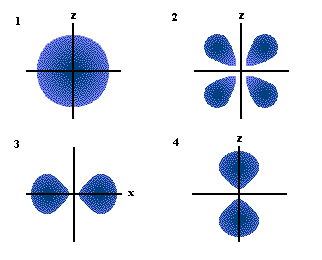|
CHAPTER THREE - ATOMIC STRUCTURE |
Directions: Use this page as a review. For each of the 20 questions there is four or five answers, choose the correct answer and you get to move on to the next question. I know this won't happen, but if you choose the WRONG answer you will be taken to an explanation of why that answer is wrong and shown the correct answer (
which will be in red), and then may be another question for you to answer.Back to
Start Page![]()
#1. The elements of the periodic table are arranged according to their:
a.
b.
Metallic characterc.
Atomic Weightd.
Alphabetically#2. The elements on the far right of the periodic table are:
a.
b.
Metalloids and unreactivec.
Noble gases and very reactived.
Noble gases and unreactive#3. What is the chemical symbol for Potassium?
a.
b.
Pc.
Pod.
Na#4. Cl is the symbol for which element?
a.
b.
Chlorinec.
Chromiumd.
Californium#5. Which law states that when two or more elements react to produce a compound, the total mass of the compound is the same as the sum of masses of the individual elements?
a.
b.
Law of multiple proportionsc.
Law of atomic theoryd.
Law of conservation of mass#6. Based on the law of conservation of mass what would be the result of the following reaction?
H2 + O2 ----> ?
a.
b.
H2O2c.
H2O4d.
H2O#7. According to one of the principles of Dalton's atomic theory
a.
b.
Atoms of the same elements combine in simple, whole-number ratios to form chemical compoundsc.
Atoms can be subdivided, created, or destroyed when they are combined separated, or rearranged in chemical reactionsd.
Atoms of a given element are not identical in their physical and chemical properties.#8. The deflection of cathode rays in Thomson's experiments gave evidence of the _________ nature of electrons.
a.
b.
Chargedc.
Particled.
Spinning#9. The nucleus of an atom:
a.
b.
Occupies a large part of the volume of an atomc.
Contains protons, neutrons, and electronsd.
Contains only protons and neutrons
Refer to this picture for questions #10

#10. According to the quantum theory, point A in the above figure represents___________.
a.
b.
the farthest point from the nucleus that an electron can achievec.
a position where an electron cannot existd.
a position where an electron probably exists#11. When energy is added to an atom, that atoms electrons are boosted to a higher energy level. They are said to be in the ____________ and the atom has _______________?
a.
b.
excited state, absorbed energyc.
ground state, released energyd.
excited state, released energy#12. The visible spectrum is located between the _________________ spectrum and the ____________ spectrum.
a.
b.
Ultraviolet, X rayc.
Ultraviolet, Infrared Heat Wavesd.
Microwaves, FM radio waves#13. The Heisenberg uncertainty principle says that you can know the _________________ of an electron.
a.
b.
Velocity and not the positionc.
Neither the velocity or the positiond.
Either the velocity or the position#14. Magnesium (Mg) with an atomic number of 12 and an atomic mass of 24 has _____________________ neutrons in the nucleus.
a.
b
.12c.
24d.
36Refer to the following picture for #15

#15. Which of the following lists correctly matches all of the orbitals with their corresponding shape from the above picture?
a.
b.
1-s / 2-dxz / 3-px / 4-pyc.
1-s / 2-dxz / 3-pz / 4-pxd.
1-dxz / 2-s / 3-px / 4-py#16. Which of the following columns is correct?
|
a. Column A s sublevel |
b. Column Bp sublevel |
c. Column Cd sublevel |
d. Column Df sublevel |
|
l = 0 |
l = 1 |
l =2 |
l = 3 |
|
1 orbital |
2 orbitals |
4 orbitals |
7 orbitals |
|
Max. of 2 electrons |
Max. of 6 electrons |
Max of 10 electrons |
Max of 16 electrons |
#17. Hund's Rule is best represented by which of the following orbital diagrams?
|
a. |
|
|
b. |
|
#18. Which of the following is the correct electron configuration for Chlorine (Cl)?
a. 1s22s22p5
d.
1s22s23s22p63p5#19. Which element has the following electron configuration? [Kr] 5s24d105p2?
a.
b.
Rbc.
Pbd.
Sn#20. Which of the following orbitals has the most energy associated with it?
a.
b.
3sc.
3pd.
4s
THIS IS THE END OF THIS CHAPTER. CLICK HERE TO GO BACK TO THE START PAGE, OR CLICK HERE TO GO BACK TO THE START OF THIS CHAPTER
![]()